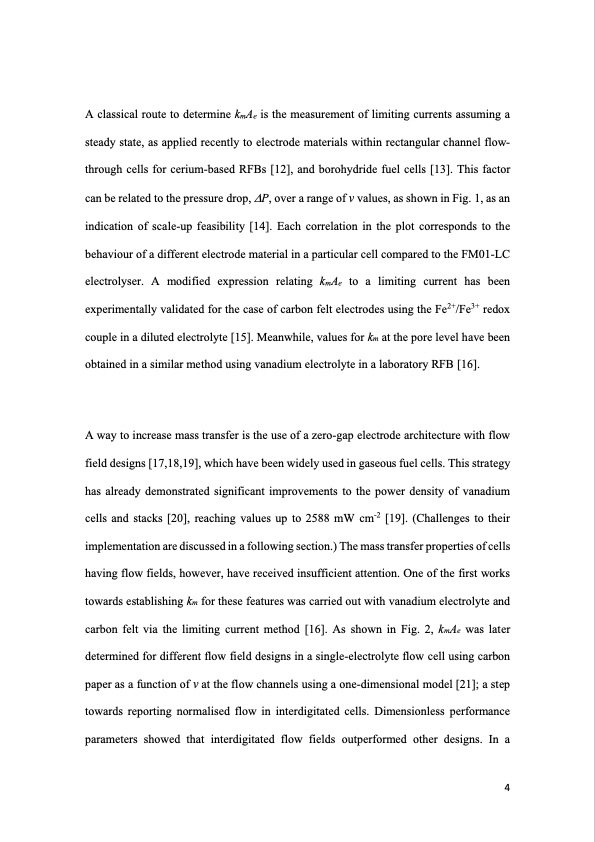
PDF Publication Title:
Text from PDF Page: 004
A classical route to determine kmAe is the measurement of limiting currents assuming a steady state, as applied recently to electrode materials within rectangular channel flow- through cells for cerium-based RFBs [12], and borohydride fuel cells [13]. This factor can be related to the pressure drop, P, over a range of v values, as shown in Fig. 1, as an indication of scale-up feasibility [14]. Each correlation in the plot corresponds to the behaviour of a different electrode material in a particular cell compared to the FM01-LC electrolyser. A modified expression relating kmAe to a limiting current has been experimentally validated for the case of carbon felt electrodes using the Fe2+/Fe3+ redox couple in a diluted electrolyte [15]. Meanwhile, values for km at the pore level have been obtained in a similar method using vanadium electrolyte in a laboratory RFB [16]. A way to increase mass transfer is the use of a zero-gap electrode architecture with flow field designs [17,18,19], which have been widely used in gaseous fuel cells. This strategy has already demonstrated significant improvements to the power density of vanadium cells and stacks [20], reaching values up to 2588 mW cm-2 [19]. (Challenges to their implementation are discussed in a following section.) The mass transfer properties of cells having flow fields, however, have received insufficient attention. One of the first works towards establishing km for these features was carried out with vanadium electrolyte and carbon felt via the limiting current method [16]. As shown in Fig. 2, kmAe was later determined for different flow field designs in a single-electrolyte flow cell using carbon paper as a function of v at the flow channels using a one-dimensional model [21]; a step towards reporting normalised flow in interdigitated cells. Dimensionless performance parameters showed that interdigitated flow fields outperformed other designs. In a 4PDF Image | Redox flow batteries for energy storage challenges

PDF Search Title:
Redox flow batteries for energy storage challengesOriginal File Name Searched:
Redox_flow_batteries_for_energy_storage.pdfDIY PDF Search: Google It | Yahoo | Bing
Salgenx Redox Flow Battery Technology: Salt water flow battery technology with low cost and great energy density that can be used for power storage and thermal storage. Let us de-risk your production using our license. Our aqueous flow battery is less cost than Tesla Megapack and available faster. Redox flow battery. No membrane needed like with Vanadium, or Bromine. Salgenx flow battery
| CONTACT TEL: 608-238-6001 Email: greg@salgenx.com | RSS | AMP |